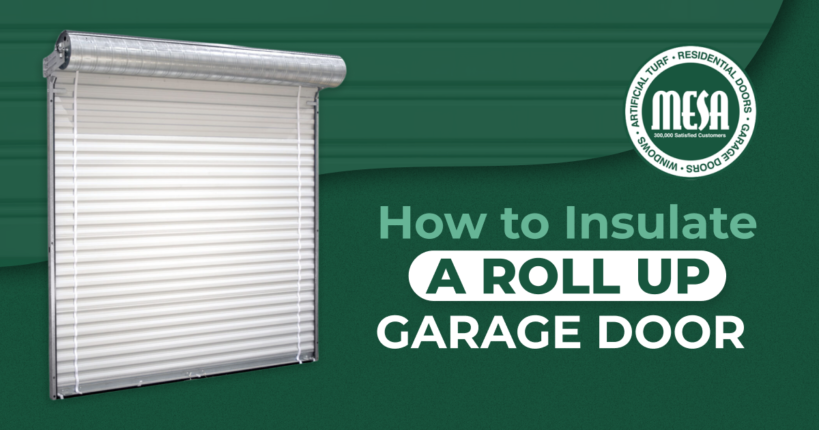How to Insulate a Roll-Up Garage Door
Insulated roll-up garage doors are used in many settings. Constructed of thin slats that form a roll on top when the door is open, they’re often found in commercial buildings. They can also be used in homes, but there are more installation challenges compared to other garage doors. One of them is finding the right insulation if the door isn’t already insulated.
While roll-up doors are great for homes with limited space and are extremely durable and secure, installing one isn’t easy. Their industrial look often requires additional painting or finishing. Also, initial installation costs are often higher than those of other garage doors. Click here to learn more about the pros and cons of roll-up garage doors, but now, we’ll explain how to insulate one so your home or business is quieter and more energy efficient.
Steps to Insulating a Roll-Up Garage Door
Most other types of garage doors use thicker foam panel insulation. However, roll-up doors must be fitted with thinner insulation materials. These prevent the door from getting stuck. That being said, the process of insulating your garage door is generally as follows:
1. Choose and Prepare Your Materials: You’ll need a 2-millimeter thick foil/foam type insulation. Foil-backed polyethylene insulation is suited for roll-up garage doors. This dual-layer material is secured with a strong adhesive. If the material doesn’t come with an adhesive, you’ll need durable, double-sided tape; sharp-tipped screws and washers are optional, but they help stabilize the material once it’s installed.
Other types of suitable insulation can include:
- Foam Board Insulation: Available in rigid panels, it offers excellent thermal resistance and provides structural support.
- Fiberglass Insulation: Fiberglass is sold in rolls or batts, so it is suited for roll-up garage doors. It is affordable and provides good thermal resistance.
- Reflective Insulation: Radiant barrier insulation has a foil-faced material that reflects heat away from your garage. It’s also lightweight and easy to install.
Another option is to purchase an insulated door. Pre-installed header seals and top and side draft stops offer protection from environmental elements. To ensure proper fitting, consider that the header seal extends up to 5 inches from the door curtain, and the top draft stop forms a 2¼ inch weather seal at the top of the door curtain.
If selecting an insulation material on your own, consider your local climate, available space, and budget. Check the product label or ask the retailer or manufacturer if the material is moisture-resistant.
2. Prepare Your Garage Door: All the metal surfaces of your roll-up garage door must be smooth and clean, so the insulating material adheres properly. First, smooth out any imperfections with fine-grit sandpaper. Then use an all-purpose cleaner and clean rag to remove dirt, debris, and grease. You can begin installation once the door panels are dry.
Hire a garage door contractor if the dirt won’t come off. At this stage, it’s also important to check the door for dents, cracks, and other damage that should be fixed before insulating it.
3. Measure and Cut: The insulation panels may need to be trimmed to fit the dimensions of your garage door. Try to find a material that’s as close to the width of your door as possible. This can save time on cutting and patching. Measure each insulation panel and match it with its corresponding door section size. Insulation can be easily cut with a utility knife; use a straightedge to make straight cuts.
4. Install the Material: Start at the top of the garage door (some experts suggest starting at the bottom). Align the material with the edges and make sure it covers the entire first panel. Once you confirm it matches, place the adhesive strip. Then press the foil side of the insulation on the double-sided tape. Overlapping the seams by 2 to 3 inches can prevent air leaks; you can also reinforce the material with tape along the sides.
Insulation panels can also be secured with screws or nails. If using these, place them along the edges of each door panel and at regular intervals. Avoid overtightening fasteners so the door is not damaged.
Continue working your way down the garage door, one subsequent panel at a time.
5. Seal the Door: After the insulation is installed, any gaps will cause air leaks that make it ineffective. Use insulating seam tape to seal these gaps. It prevents hot or cold air from getting into and out of your garage and also protects the edges from dirt.
6. Make Sure Your Garage Door Works: Your roll-up garage door should now be tested. Turn it on to make sure it opens and closes properly. Inspect the insulation if the door snaps or binds. Cut any excess material if the insulation interferes with the door’s operation.
Helpful Tips
When insulating a roll-up garage door, you can increase the material’s insulating ability by:
- Installing a weather seal at the bottom edge of the door.
- Insulating hardware and hinges with special tape or adhesive-backed foam strips.
- Adjusting the door balance if it’s noisy or lopsided.
- Ensuring your garage is properly ventilated.
- Choosing high-quality, high-value insulating materials.
Contact Mesa Garage Doors
Based in Anaheim, CA, we install and repair garage doors throughout Southern California. Our experienced technicians are familiar with many types of garage doors and help choose from a wide range of options. Whether you need a certain color to enhance your home’s exterior, want windows installed in your garage door, or have a roll-up garage door that needs to be insulated, we’re ready to help. Give us a call at (800) 893-1107 today.





